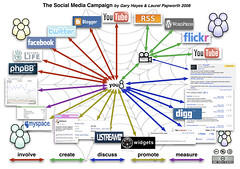Blog Archives
Most SEO people agree that having a single dash or hyphen (-) in a domain name is not a bad thing. Technically, the search engines still see the keywords in the URL and ignore the hyphens.
In the past, spammers have over-used hyphens to try and direct unsuspecting users to their own websites. Having two to three hyphens in a domain name is what has given hyphenated domains such a bad reputation.
Several articles point to the fact that hyphenated domains still appear in Google’s results (and many of these websites are high quality), and are therefore not being penalized for having hyphens.
Using hyphens is not good for branding a specific product or service, but a keyword rich domain name with a dash will still rank highly.
Sources:
Jon Rognerud (Author of The Ultimate Guide to Search Engine Optimization), personal communication.
http://www.werockyourweb.com/domain-name-with-or-without-hyphens (Feb 2012)
Hyphenated Domain Names: Use Or Avoid?
Posted on January 5, 2012 by Sergie Matthis
http://kevin-pike.com/hyphenated-domain-names-use-or-avoid/

I have been noticing a worrisome trend lately. Many businesses have decided to go with social media (i.e. Facebook, Twitter, etc.) before making sure that 1) their website is fully optimized for users (or search engines), or 2) that their website is fully functional.
While I agree that using social media is a very useful technique for pushing people to a website, there needs to be a fully usable website on the other end. There is nothing so frustrating as following a link in Twitter, only to discover that the information you’re interested in can’t be found on that particular page.
Another problem is that social media is transient in its very nature. What is popular today may not be popular tomorrow. You must make sure that your website will be found by people who are not only active in social media, but who are looking for your site in the search engines using particular keywords.
Before you jump on the social media bandwagon, you must make sure that your website is not only user-friendly, but search engine friendly as well. Optimizing your website is crucial for the long term. I know, I know, doing SEO on your website is not as exciting as posting to your friends on Twitter, but think of it as a necessity, as a way of standing out in the crowd of websites.

A good way of getting more keywords on a website is to put together a glossary of terms. This has two main advantages.
First, by putting in a list of definitions, you make the website more of a content site, and one that will be seen for information. It is a great service to your customers and prospects as well.
A great example of this is Grand Entrances . I helped set up this glossary of terms about doors (and learned a lot while doing it). Now, when customers come to the website, they can better understand what the descriptions are referring to.
Secondly, a glossary allows you to pinpoint the keywords that you want the search engines and users to see. Often, a website has too many keywords to be clumped together on the home page. With a list of terms, you can both inform and educate.

In order to rank well on the search engines, you need to have other websites pointing to your website. These are known as inbound links. There are a number of ways of getting inbound links to your site, and several older techniques that are no longer very useful.
One of these older techniques is known as a link exchange. Link exchanges are when a number of different websites agree to exchange links. Nowadays, this method only works if you can find related websites to your subject that do not compete with you.
In other words, if you are selling furniture online, you would welcome links from websites selling furniture polish or soap, since they are not competing with you. However, if your website is about pets, you would not want a website selling animal traps to link to you.
The best way to get inbound links is to use search engines to find popular websites that are in your general field. You can then ask for a return link. I suggest emailing the webmaster for the link, using your own words, not some canned program.
Keep in mind that you do not want a lot of links all at once. That will look suspicious to the search engines. Gradual link building is best.

Image by mringlein via Flickr
I gave a talk recently to my SEO Meetup about the 10 biggest SEO Mistakes. I discovered that there are way more than just 10, so I grouped them into three basic sections: Web Design; Title and Meta Tags; and Linking.
Of course the absolute BIGGEST mistake is not to do SEO at all, but I presume that you already know that.
Web Design
DON’T
Put a splash or doorway page on the website. This is a page with no text that a user has to click on to enter the actual website. We have all seen this, there is a big graphic, or a Flash movie, and a small “Skip Intro” button at the bottom somewhere. Why upset your users when they come in to the website? Remember, you only have 7 seconds to grab their attention.
Use frames on the site. An example is a website that is cut into boxes where the text scrolls down but the design stays put. This includes I-Frames. Fortunately, most designers no longer fool with frames, but i-Frames are just as bad. Try printing out a web page that has frames and you will get two blank pages and one of text. Which one will the search engine see? The blank ones.
Have a Flash movie on the first page. Most search engines cannot see Flash, and will not index your website as a result. Even though Adobe supposedly gave Yahoo and Google information on Flash, the programs cannot see your images. However, you can embed the Flash video in a static HTML page. This allows the search engine to index the page and your users still can see the lovely movie.
Use graphics with text in them (i.e. like a page header with your tagline in it). Again, search engines cannot see graphics and will miss the important data.
Have a lot of flashing and blinking animations on your website. This is distracting to the user and “so last century”.
Please do not try fancy navigation buttons. These often lead to confusing both the users and the spiders. You want to have straightforward, easy to read / see navigation links throughout the website.
DO
Have at least a paragraph of text on the first (or home) page. This allows the search engines to properly classify the site and helps the users as well (7 second rule).
Have your contact information at the bottom of each page or in a visible location (such as a Contact Us page). This boosts credibility.
Use your most important key terms in the text of the pages, so that the search engines and your prospective clients can find you.
Make sure that the navigation of the website is clear and simple to use. If a user cannot navigate your site, they will leave.
Make sure that there are no broken links on the website. This means checking back every few months.
Part 2 will cover Linking.
There are a lot of untruths floating around the Web about SEO. I often hear them when clients bring them up to me. New ebooks on SEO are constantly popping up with headlines like, “Rank First on the Search Engines!” or “Learn the Secrets that SEO people won’t tell you!”
Well, as an SEO guru (and I was a guru long before most of the others, LOL), I’ll tell you right now, the most important tag in your website code is the title tag.
The title tells not only the search engines, but your users what the website is about. It should be no longer than 60 characters, and should have your most important keywords in it. But, it needs to be a title, NOT a string of keywords stuck together.
Here are some examples of titles that I have recently placed on websites:
Jewell Entertainment: Your Agency for Unforgettable Events (this is for an entertainment agency that places talent at events)
Tamara Alter: Unique Gemstone Jewelry (a jewelry designer)
Arenson Office Furniture: San Diego’s Workspace Solutions (office furniture store in San Diego)
Grand Entrances: San Diego’s Finest Custom Entry Doors (‘nuf said)
Once Upon A Favor: Wedding and Baby Shower Favors (wedding and party favors)
Now, once the title is correct on the home page, it needs to change for all the inner pages in order to reflect content. So, on the About Us page, the title would say: Once Upon A Favor: About Us and so on.
A lot of people make the mistake of just repeating the same title tag over and over. It does not help your users find their way through your website.
There are a lot of automatic submission (i.e. to search engines) programs online that promise a lot, but only deliver a little. A number of them claim that they submit to over x number of search engines. If the number is over 1,000, a red alarm light should go off! Usually, this number refers to FFA (Free-For-All or link farms) sites, or classified ad sites. You do NOT want your site submitted there.
A client asked me to look at a company that he was paying to do the submission of his website. After carefully checking through their list (they said it was at least 3,000 search engines and directories), I found that there were only 304 actual websites. And, of those, only 26 were real search engines, and 16 were pay-per-click search engines. The other links included dead sites, foreign language sites that do not accept English language websites, meta search engines that do not even accept submissions, and a number of sites that had nothing to do with search engines at all!
There are also a number of programs that will submit your site to directories for a fee. Unfortunately, the program submits the website blindly to any directory it has in its list. As a result, your site gets submitted to directories that have nothing to do with your field. One client, who sells Turkish cotton bathrobes, found his site had been submitted to a Greek tourism directory.
When I submit a website to a search engine or directory, I know that the site will accept the link because I have done the research.